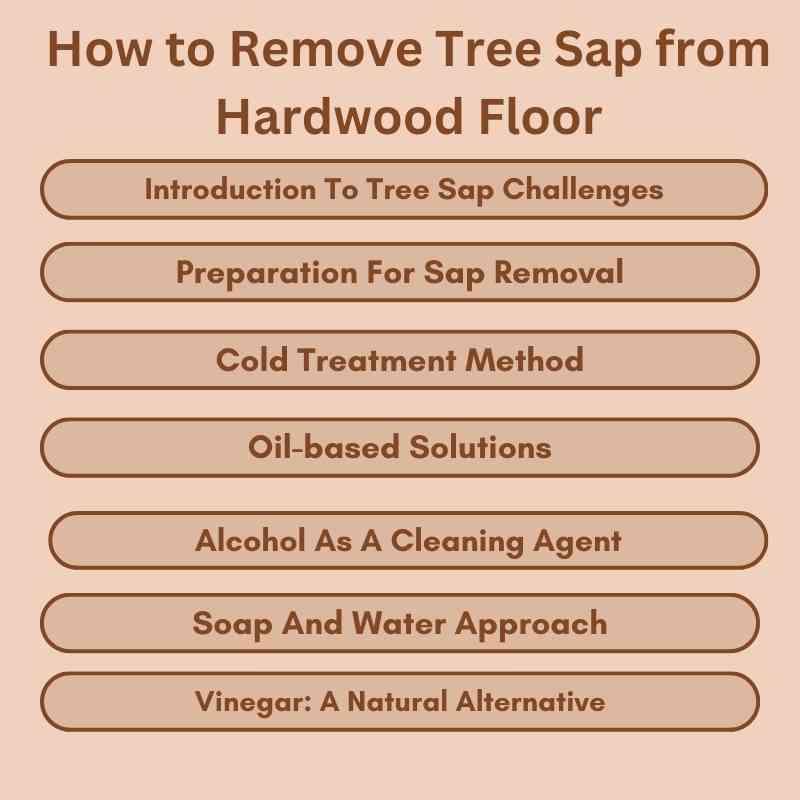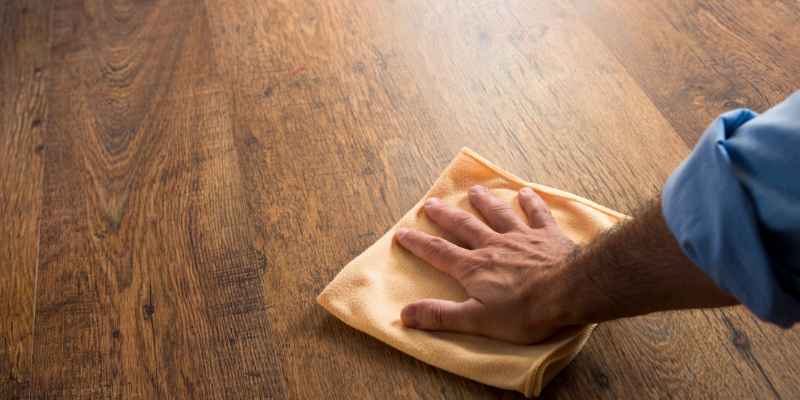To remove tree sap from hardwood floors, wipe the sap with a warm, damp towel containing a small amount of soap. If the sap has been there for a few hours or longer, try soaking it in oil soap for fifteen minutes before wiping it away.
This method is safe for hardwood floors and helps to dissolve and remove the sticky sap.
Introduction To Tree Sap Challenges
To remove tree sap from hardwood floors, try placing an ice cube on the sap to harden it, then gently pop it off. Follow up by cleaning the area with a hardwood floor cleaner, like Bona Hardwood Floor Cleaner. Avoid using harsh chemicals or abrasive materials that could damage the floor.
The Sticky Situation With Hardwood Floors
Tree sap can pose a sticky challenge for hardwood floors, causing frustration for homeowners. The gooey substance can be challenging to remove and may leave behind stubborn stains if not treated promptly. It is essential to address tree sap on hardwood floors carefully to avoid damaging the surface.
Why Prompt Removal Is Key
When tree sap is left unattended on hardwood floors, it can harden and become even more difficult to remove. Prompt action is crucial to prevent the sap from seeping into the wood and causing long-term damage. Timely removal also minimizes the risk of discoloration and preserves the natural beauty of the hardwood.
Preparation For Sap Removal
To prepare for sap removal from hardwood floors, start by placing an ice cube on the sap to harden it. Once hardened, carefully pop off the sap using a plastic scraper or credit card. Follow up by cleaning the area with a warm, damp towel and a little bit of soap.
Gathering Necessary Supplies
Before you begin the process of removing tree sap from your hardwood floor, gather all the necessary supplies. You will need a plastic scraper, rubbing alcohol, a clean cloth, and a vacuum cleaner with a hose attachment. Make sure the plastic scraper is gentle and won’t scratch your hardwood floor. You can also use a credit card or a plastic spatula in case you don’t have a plastic scraper.
Protecting The Floor’s Finish
Before you start removing the sap, make sure to protect the floor’s finish. The rubbing alcohol used in the process can damage the finish of your hardwood floor. To protect the finish, place a cloth under the affected area to catch any drips. You can also use painter’s tape to protect the surrounding area from rubbing alcohol.
Removing The Sap
Now that you have gathered all the necessary supplies and protected the floor’s finish, it’s time to remove the sap. Follow these steps to remove the sap:
- Use the plastic scraper to gently scrape off as much sap as possible.
- Pour rubbing alcohol on a clean cloth and gently rub the remaining sap until it comes off.
- Use a vacuum cleaner with a hose attachment to clean up any remaining residue.
- Clean the hardwood floor with a hardwood floor cleaner to remove any traces of sap and rubbing alcohol.
Removing tree sap from hardwood floors can be a daunting task, but with the right tools and techniques, it can be done easily. Remember to gather all the necessary supplies, protect the floor’s finish, and follow the steps outlined above to remove the sap. With a little patience and effort, your hardwood floor will be looking as good as new.
Cold Treatment Method
If you’ve discovered tree sap on your beautiful hardwood floors, don’t panic! The cold treatment method can effectively remove the stubborn sap without causing any damage to your flooring. By using ice to harden the sap, you can easily scrape it off and restore the pristine condition of your hardwood floors. Here’s how you can do it:
Step 1: Prepare The Ice Cubes
Start by grabbing a few ice cubes from your freezer. Place them in a plastic bag or a clean cloth to prevent water from dripping onto your hardwood floor. It’s important to keep the ice contained to avoid any potential water damage.
Step 2: Apply The Ice To The Sap
Take the ice-filled bag or cloth and gently press it onto the tree sap on your hardwood floor. Hold it in place for a few minutes to allow the cold temperature to harden the sap. The low temperature will cause the sap to solidify, making it easier to remove.
Step 3: Safely Scrape Off The Sap
Once the sap has hardened, carefully scrape it off using a plastic scraper or a credit card. Be gentle to avoid scratching the surface of your hardwood floor. If needed, you can use a soft cloth or sponge dampened with warm water to wipe away any residue.
Step 4: Clean The Area
After successfully removing the tree sap, it’s important to clean the area thoroughly. Use a hardwood floor cleaner, such as Bona Hardwood Floor Cleaner, to wipe the affected area. Follow the manufacturer’s instructions and ensure the cleaner is suitable for your specific type of hardwood flooring.
By following these steps, you can effectively remove tree sap from your hardwood floors using the cold treatment method. Remember to always test any cleaning solution on a small, inconspicuous area of your floor before applying it to the sap to avoid any potential damage. With a little patience and the right technique, your hardwood floors will be sap-free and looking as good as new!
Oil-based Solutions
When it comes to removing tree sap from hardwood floors, oil-based solutions can be highly effective. By employing olive or vegetable oil, you can easily tackle this sticky problem. In this section, we will explore the application and cleaning techniques using these oils.
Employing Olive Or Vegetable Oil
To remove tree sap from hardwood floors, olive or vegetable oil can be used as a natural solvent. Here’s how you can do it:
- Start by applying a small amount of olive or vegetable oil directly onto the sap stain.
- Allow the oil to sit on the sap for a few minutes to penetrate and loosen it.
- Gently rub the area with a soft cloth or sponge to break down the sap.
- Continue rubbing until the sap is completely removed from the hardwood surface.
Application And Cleaning Techniques
When applying olive or vegetable oil, it’s essential to follow specific techniques to ensure optimal results:
- Always test the oil on a small, inconspicuous area of the hardwood floor to ensure it doesn’t cause any damage or discoloration.
- Use a clean cloth or sponge to apply the oil directly to the sap stain, ensuring it is fully saturated.
- Allow the oil to sit on the sap for a few minutes, giving it time to dissolve and break down the sticky residue.
- Gently scrub the area using a circular motion, applying light pressure to avoid scratching the hardwood surface.
- Once the sap is loosened, wipe away the oil and sap residue with a clean, damp cloth.
- Afterward, clean the hardwood floor with a mild hardwood floor cleaner to remove any remaining oil residue.
- Dry the floor thoroughly with a clean towel to prevent any moisture damage.
By following these oil-based solutions and techniques, you can effectively remove tree sap from your hardwood floors, restoring their natural beauty and shine.

Alcohol As A Cleaning Agent
To remove tree sap from hardwood floor, one effective cleaning agent is rubbing alcohol. Soak a cloth in rubbing alcohol and apply it to the affected area, letting it sit for a few minutes. Then, gently scrub the sap away using a clean cloth.
Repeat the process until the sap is completely removed.
Isopropyl Alcohol For Tough Residue
Isopropyl alcohol, also known as rubbing alcohol, is a powerful solvent that can effectively remove tough tree sap residue from hardwood floors. It works by breaking down the sap’s sticky texture and dissolving it away from the floor surface.
To use isopropyl alcohol for cleaning, simply dampen a clean cloth with the solution and apply it to the affected area. Allow it to sit for a few minutes to penetrate the sap, then gently scrub the area with the cloth until the sap is removed. Rinse the area with warm water and dry it thoroughly.
Hand Sanitizer For A Quick Fix
If you are in a hurry and need a quick fix to remove tree sap from your hardwood floor, hand sanitizer can do the trick. Hand sanitizers contain a high concentration of alcohol, which makes them effective in dissolving the sap.
To use hand sanitizer for cleaning, simply apply a small amount to a clean cloth and rub it onto the affected area. Gently scrub the area until the sap is removed, then rinse the area with warm water and dry it thoroughly.
In conclusion, alcohol is an effective cleaning agent for removing tree sap from hardwood floors. Isopropyl alcohol is best for tough residue, while hand sanitizer is a quick fix for smaller areas. Remember to always test a small, inconspicuous area before using any cleaning solution on your hardwood floor.
Soap And Water Approach
When dealing with tree sap on hardwood floors, a gentle soap and water approach can be effective in removing the sticky residue without causing damage.
Making A Warm Soapy Mixture
To start, create a warm soapy mixture using mild dish soap diluted in water. Ensure the solution is not too harsh to avoid damaging the hardwood surface.
Gentle Scrubbing Without Damage
- Soak a soft cloth or sponge in the warm soapy mixture.
- Gently scrub the affected area, applying light pressure to lift the tree sap off the hardwood floor.
- Continue scrubbing until the sap is completely removed.
Remember to dry the area thoroughly after cleaning to prevent any moisture damage to the hardwood floor.
Vinegar: A Natural Alternative
To remove tree sap from hardwood floors, consider using vinegar as a natural alternative. Simply mix equal parts of vinegar and water, apply it to the affected area, and gently scrub to remove the sap. This eco-friendly solution effectively cleans the hardwood floor without causing any damage.
How To Use White Vinegar
To remove tree sap from hardwood floors using white vinegar, mix equal parts of white vinegar and water in a spray bottle.
Precautions And Tips
- Test the solution on a small, inconspicuous area first.
- Avoid using undiluted vinegar as it may damage the wood.
- Gently dab the affected area with a soft cloth soaked in the vinegar solution.
- Rinse the area with a clean, damp cloth afterward.
- Dry the floor immediately to prevent any water damage.
Post-cleaning Care
To remove tree sap from hardwood floors, start by applying ice to harden the sap, then gently scrape it off with a plastic scraper. Wipe the area with a damp cloth and a small amount of dish soap to remove any residue.
Finally, dry the area thoroughly to prevent any damage to the wood.
After removing tree sap from your hardwood floor, it is essential to follow proper post-cleaning care to maintain the floor’s quality and appearance. Here are some crucial steps to take:
Buffing The Floor To Restore Shine
To restore the shine of your hardwood floor after sap removal, consider buffing the surface. Use a quality hardwood floor buffer to bring back the natural luster of the wood.
Preventive Measures For Future Spills
To prevent future sap spills on your hardwood floor, consider implementing the following preventive measures:
- Place rugs or mats in high-traffic areas to catch any spills before they reach the floor.
- Regularly sweep or vacuum the floor to remove any debris that could potentially lead to sap stains.
- Immediately clean up any spills or sticky substances to prevent them from hardening on the floor.
Common Questions Answered
To remove tree sap from hardwood floors, start by applying ice to harden the sap, then gently scrape it off with a plastic scraper. Wipe the area with a cloth dampened with mineral spirits to remove any residue. Finally, clean the floor with a hardwood floor cleaner to restore its shine and finish.
Can Dawn Soap Remove Tree Sap?
Yes, Dawn soap can effectively remove tree sap from hardwood floors. Simply mix a small amount of Dawn soap with warm water and gently scrub the affected area using a soft cloth.
Does Vinegar Dissolve Tree Sap?
Distilled white vinegar is a great natural solution to dissolve tree sap from hardwood floors. Fill a spray bottle with vinegar, generously spray the affected area, and let it sit for a few minutes before wiping it clean with a damp cloth.
Professional Advice
To remove tree sap from hardwood floors, try placing an ice cube on the sap and then gently popping it off. Follow up by cleaning the area with a warm, damp towel and a small amount of soap. Avoid using harsh chemicals that can damage the wood.
Removing tree sap from hardwood floors can be a challenging task, especially if it has been left for a long time. While there are several DIY methods that you can use to get rid of the sap, sometimes it’s best to call a professional to avoid damaging your floors. In this section, we’ll discuss when to call a professional and how to maintain your hardwood floor after sap removal.
When To Call A Professional
If you’re dealing with a large amount of sap or if the sap has been left on your hardwood floors for an extended period, it’s best to call a professional. They have the expertise and the right tools to safely remove the sap without damaging your floors. Attempting to remove the sap on your own could result in scratches, discoloration, or even gouges on your hardwood floors. So, if you’re unsure or uncomfortable with the DIY methods, it’s best to leave it to the professionals.
Maintaining Hardwood Floor After Sap Removal
After the sap has been removed, it’s crucial to maintain your hardwood floors to prevent future damage. Here are some tips on how to maintain your hardwood floors after sap removal:
- Regularly sweep or vacuum your floors to remove dirt and debris that can scratch or damage your floors.
- Use a damp mop or cloth to clean your floors, avoid using a wet mop as it can damage your floors.
- Avoid using harsh chemicals or abrasive cleaners on your hardwood floors.
- Place mats or rugs in high traffic areas to prevent wear and tear on your hardwood floors.
- Trim your pet’s nails regularly to avoid scratches on your floors.
By following these tips, you can maintain the beauty of your hardwood floors and prevent future damage.
In conclusion, removing tree sap from hardwood floors can be a daunting task, but with the right tools and techniques, you can get rid of it without damaging your floors. However, if you’re unsure, it’s best to call a professional. And once the sap has been removed, it’s essential to maintain your floors to prevent future damage.

Frequently Asked Questions
Will Dawn Soap Remove Tree Sap?
Yes, Dawn soap can remove tree sap. Just apply a small amount of Dawn soap directly to the sap, let it sit for a few minutes, and then scrub gently with a cloth or sponge. Rinse with water afterwards. Dawn’s powerful formula helps break down and remove the sticky sap effectively.
How Do You Remove Sticky Sap From Wood?
To remove sticky sap from wood, apply a small amount of olive or vegetable oil and let it sit for a few minutes. Then, gently wipe the sap away with a clean cloth. Finally, clean the area with warm, soapy water to remove any residue.
Does Vinegar Dissolve Tree Sap?
Yes, vinegar can dissolve tree sap. Fill a spray bottle with distilled white vinegar and spray it generously on the affected area. Let it sit for three to five minutes before wiping it off.
What Is The Easiest Way To Remove Tree Sap?
To remove tree sap, use diluted isopropyl alcohol to break the bond and wipe with a clean cloth. For vertical surfaces, hand sanitizer gel with alcohol is effective. Another option is to apply olive or vegetable oil, then clean the affected area.
Always test on a small area first.
Conclusion
Removing tree sap from hardwood floors is a manageable task with the right approach. Whether using ice, oil, or alcohol-based solutions, it’s crucial to act promptly and gently to avoid damaging the wood. Regular cleaning and maintenance can prevent sap buildup, preserving the natural beauty of your hardwood floors for years to come.

